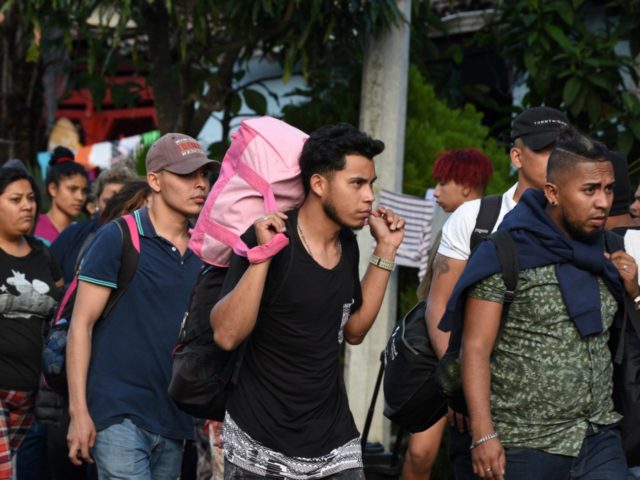The Washington Post reports the huge migration out of Guatemala and into U.S. workplaces is driven by basic economics, despite Democrats’ lockstep claims the migration is driven by fear of crime and abuse.
The Post story carried the headline, “The migration problem is a coffee problem,” and the subheadline “In western Guatemala, cultivating coffee was once a way out of poverty. As prices fall, growers are abandoning their farms for the United States.”
However, the report from Guatemala quietly ignored the legal reality the migrants are illegal immigrants because U.S. asylum law protects people fleeing persecution — not people fleeing a disastrous drop in coffee prices. This long-standing legal exclusion of economic migrants is intended to protect ordinary Americans and their families from investors’ use of wage-cutting migrant labor.
The Post also provided multiple examples of migrants using their young children to trigger the establishment’s catch-and-release loopholes to get themselves into U.S. jobs. For example, the article features Rodrigo Carrillo, a tough coffee farmer in the village of Hoja Blanca, who bought his small farm with money earned working illegally in the United States:
Last month, he pulled out a wrinkled map of the U.S.-Mexico border and pointed to the spot on the edge of Arizona where he plans to cross with his 5-year-old son.
“I’m leaving in 11 days,” he said. “There’s no money in coffee anymore.”
Guatemala is now the single largest source of migrants attempting to enter the United States — more than 211,000 were apprehended at the Southwest border in the eight months from October to May. Here in western Guatemala, one of the biggest factors in that surge is the falling price of coffee, from $2.20 per pound in 2015 to a low this year of 86 cents — about a 60 percent drop. Since 2017, most farmers have been operating at a loss, even as many sell their beans to some of the world’s best-known specialty-coffee brands.
…
Carrillo and his wife, Marbel, started planning their own migration route. He still had contacts in South Carolina. He knew how much they could earn there — roughly $8 per hour. Marbel migrated first, with their youngest son, in March. She sends Carrillo videos and photos from her job, painting an apartment complex near Greenville.
But Democrats insist the migration is a humanitarian problem, and that Americans are obliged to provide asylum to much of Central America. Sen. Dianne Feinstein, for example, told a hearing on Tuesday:
These vulnerable parents and children have experienced violence, abuse, and poverty in their home countries, particularly the Central American countries, before they begin the arduous journey north.
This month, several hundred African migrants pushed their way into the United States via the catch-and-release rules which are quietly preserved by most legislators and reporters in Washington DC.
Many legislators use a variety of reasons as they take turns blocking reform measures — such as President Donald Trump’s 2018 proposals — so allowing different blocs of legislators to pose as immigration reformers before each election.
The drop in Guatemalan coffee prices is caused by rising production in Brazil, Vietnam, and other developing countries, where production levels and efficiency are being boosted by labor-saving machinery. Guatemalan peasants cannot pick and process coffee nearly as fast as can sophisticated Brazilian coffee companies:
Amusingly, the Washington Post‘s article showed how economic 101 — supply and demand — is pushing coffee prices downward amid a surplus, yet its immigration writers rarely apply the same Economics 101 rule to the many white-collar and blue-collar Americans whose wages are forced down amid a surplus of government-imported legal and illegal immigrants.
Immigration Numbers
Each year, roughly four million young Americans join the workforce after graduating from high school or university.
But the federal government then imports about 1.1 million legal immigrants and refreshes a resident population of roughly 1.5 million white-collar visa workers — including approximately one million H-1B workers — and approximately 500,000 blue-collar visa workers.
The government also prints out more than one million work permits for foreigners, tolerates about eight million illegal workers, and does not punish companies for employing the hundreds of thousands of illegal migrants who sneak across the border or overstay their legal visas each year.
This policy of inflating the labor supply boosts economic growth for investors because it ensures that employers do not have to compete for American workers by offering higher wages and better working conditions.
This policy of flooding the market with cheap, foreign, white-collar graduates and blue-collar labor also shifts enormous wealth from young employees towards older investors, even as it also widens wealth gaps, reduces high-tech investment, increases state and local tax burdens, and hurts children’s schools and college educations. It also pushes Americans away from high-tech careers and sidelines millions of marginalized Americans, including many who are now struggling with fentanyl addictions. The labor policy also moves business investment and wealth from the heartland to the coastal cities, explodes rents and housing costs, shrivels real estate values in the Midwest, and rewards investors for creating low-tech, labor-intensive workplaces.

COMMENTS
Please let us know if you're having issues with commenting.